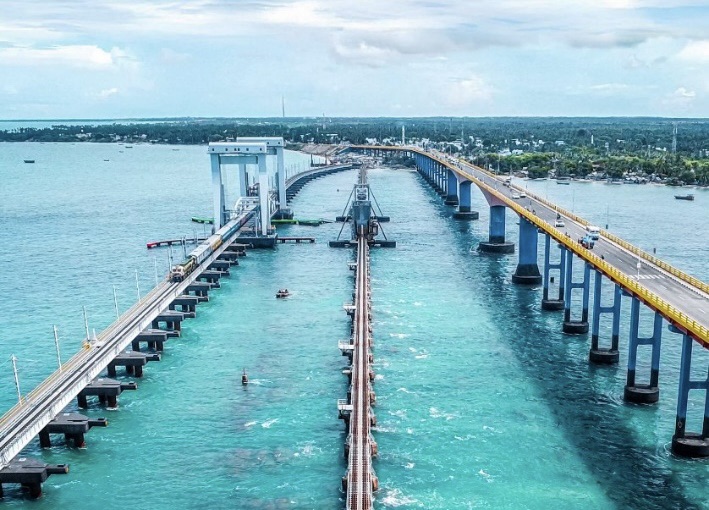New Pamban Bridge: Nation’s pride – testament to Engineering Excellence
Pradeep Gaur, CMD/RVNL
Introduction: A Bridge of Historic Significance: In the southern coastal expanse of India, connecting the mainland to the revered Rameswaram Island, stands the newly constructed Pamban Bridge – an engineering marvel poised to redefine connectivity, safety and functionality. The New Pamban Bridge is replacing the historic structure (Old Pamban Bridge) that stood for more than 100 years. The new bridge manifests India’s commitment to modernizing its infrastructure while respecting its rich heritage.
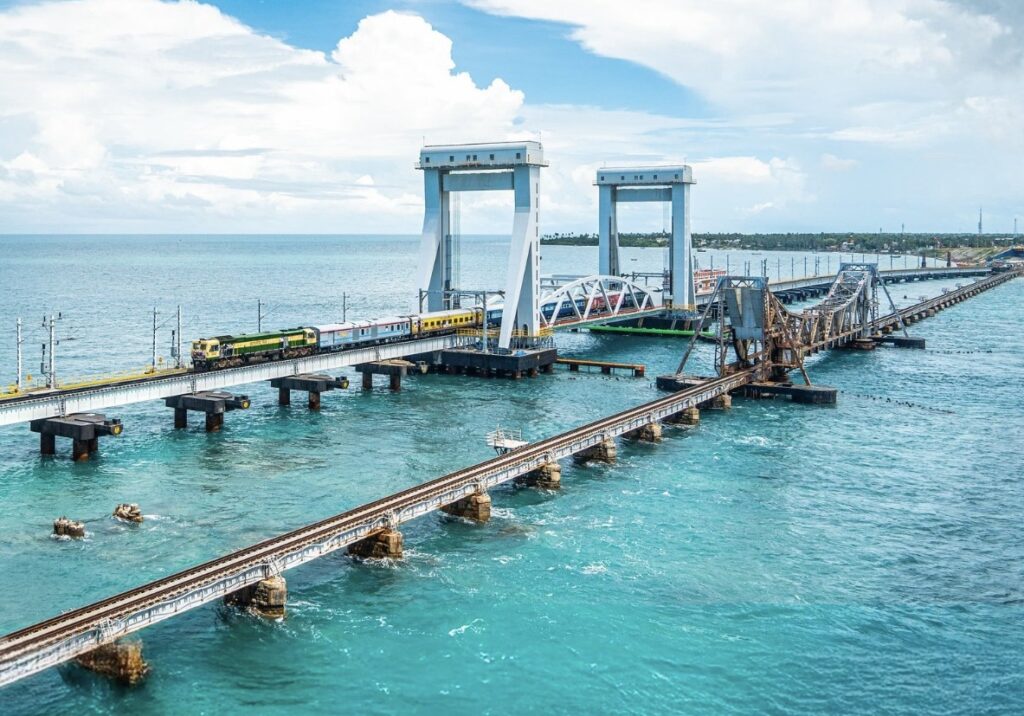
This new Railway Sea bridge between Mandapam Railway Station and the Rameshwaram island is not just a replacement for the old Pamban Bridge; it represents a colossal leap in India’s engineering capabilities. As India’s first-ever vertical lift sea bridge, it addresses challenges ranging from technological advancements to environmental resilience and global connectivity and stands as a symbol of aspirational and resurgent India.
This majestic new structure, an awe-inspiring testament to human ingenuity heralds a new era in connectivity, safety and sustainable infrastructure.
Historical Legacy of the Pamban Bridge
Before we explore the remarkable features of the New Pamban Bridge, it is crucial to recognize the historical significance of its predecessor. The original Pamban Bridge, completed in 1914, was India’s first sea bridge. Spanning 2.078 kilometers, it connected the mainland (Mandapam Town) of Tamil Nadu to Rameswaram Island, crossing the Palk Strait. Its Scherzer rolling lift span, which allowed maritime traffic to pass beneath it, made it an innovative marvel way ahead of its time. The bridge was a lifeline for pilgrims travelling to the sacred Ramanathaswamy Temple in Rameswaram and played a critical role in transport.
The Need for the New Pamban Bridge
However, as the old bridge began to show signs of wear and tear after more than 100 years of service, becoming increasingly difficult to maintain due to heavy corrosion, the need for a replacement with modern structure was felt.
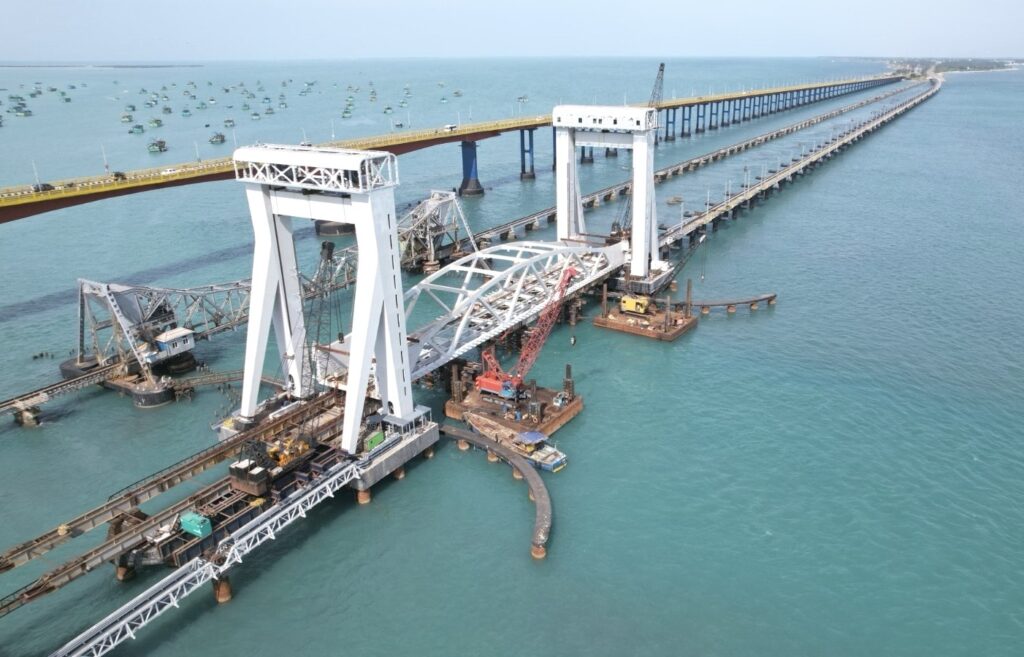
Given the unique challenges posed by the region’s geography—seismic activity, cyclonic storms and corrosive marine conditions—it became imperative to design a bridge that could withstand these harsh elements while also serving the evolving needs of India’s rail network. Furthermore, the increasing volume of rail traffic, both passenger and freight, necessitated a modern bridge capable of handling higher speeds, heavier loads and efficient maritime passage.
Thus, the decision to build the New Pamban Bridge was made and Rail Vikas Nigam Limited (#RVNL, a Navratna PSU), under the Ministry of Railways, was entrusted with the responsibility of transforming this vision into reality.
RVNL’s Role: Designing, Planning
As the nodal agency for this ambitious infrastructure project, RVNL’s role extended from concept to commissioning and not a mere construction of new bridge. Our commitment was to deliver a structure that would not only meet the needs of the present but also preserve region’s connectivity and economic vitality for time to come. Thus the project was not merely a replacement to an old bridge; it was about setting a new benchmark in modern bridge engineering.
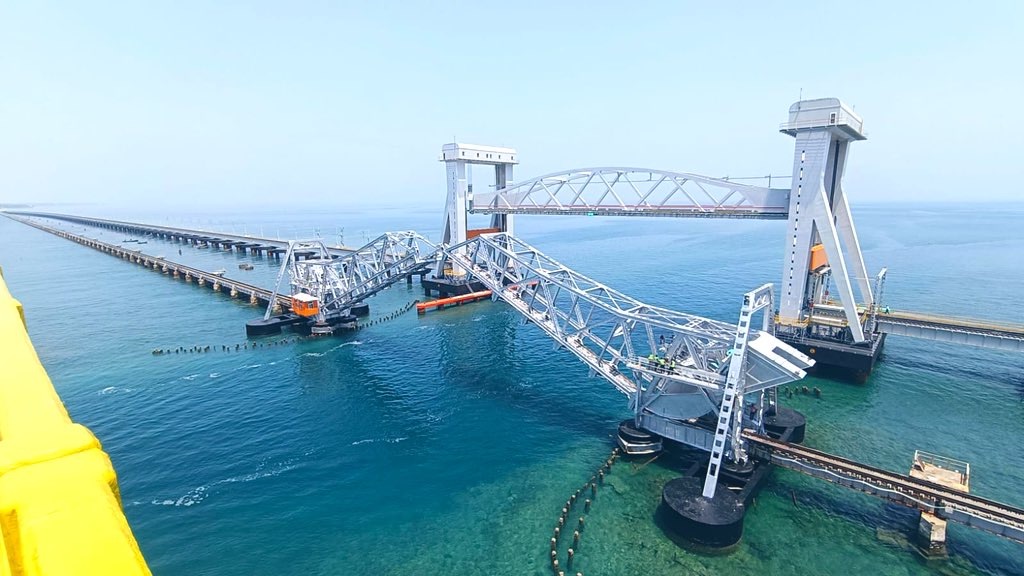
Under #RVNL, a dedicated and multi-disciplinary team of Engineers, Planners and Technicians worked extremely hard to design and implement state of art solutions.
The design and construction of the new Pamban Bridge was a highly complex, technically demanding task. The bridge had to be built in the adjacent location as the existing bridge, while ensuring that maritime and railway traffic continued seamlessly. The challenges posed by the unpredictable sea, coastal weather conditions, and the requirement for an opening span for ships to pass made it a challenge of the highest order.
The new Pamban Bridge is designed as a vertical lift structure with state of art electro-mechanical system. With advanced geotechnical studies, hydrodynamic analysis and the use of durable corrosion-resistant materials, we ensured the longevity and strength of the structure. We also used modern construction techniques to speed up the process while ensuring the highest levels of quality control.
Challenges in Construction-Overcoming the Odds
The construction of the new Pamban Bridge presented numerous challenges, ranging from environmental obstacles to logistical complexities. The Palk Strait’s turbulent waters, strong winds, and unpredictable weather patterns created difficulties in the construction process. Additionally, the region’s susceptibility to cyclones and seismic activity necessitated careful planning and robust design.
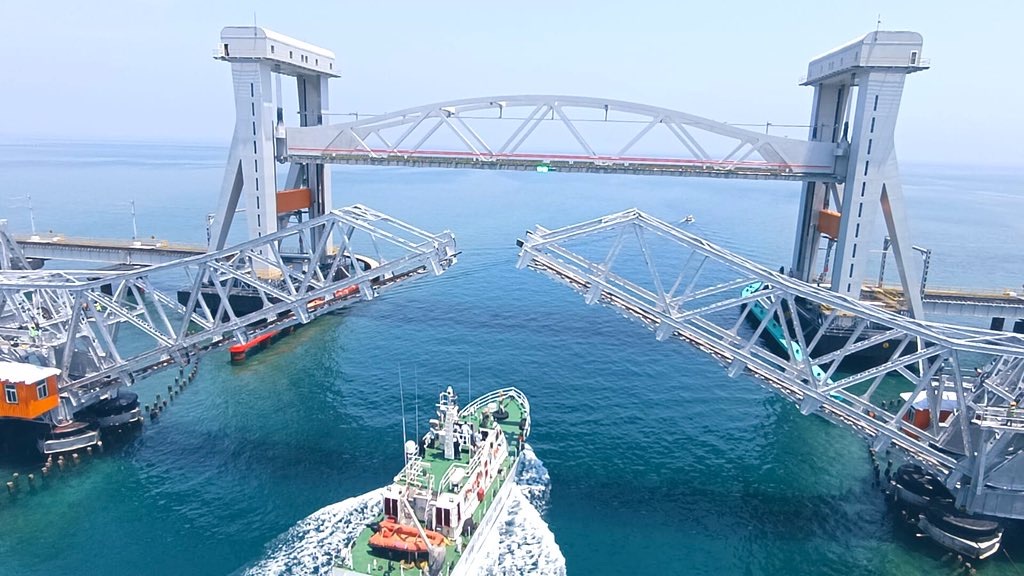
Logistically, transporting heavy materials to the remote construction site posed another challenge. The narrow windows of opportunity provided by the tides had to be maximized to facilitate the timely delivery of materials. Despite these hurdles, the team of engineers and workers displayed exceptional ingenuity innovative solutions, cutting-edge technology and sheer determination in overcoming the challenges and thereby ensuring the successful completion of the bridge.
It is matter of great pride that doing the course of work involving more than 1400 tons of fabrication, launching of lift spans and 99 girders, track and electrification work in the sea, the whole work was absolutely injury free. This is testimony to RVNL’s working methods, safety, health and sustainable construction.
Collaboration and Team Efforts
Such a monumental project would not have been possible without the collaborative effort of various stakeholders. #RVNL worked closely with the Ministry of Railways, Southern Railway, Government of Tamil Nadu, and a number of Contractors, Suppliers, and Consultants. The project involved cross-functional teams from civil engineering, electrical engineering, signal engineers, marine engineering and environmental science, who contributed to make the new Pamban Bridge a reality. It is a matter of absolute pride the new Pamban Bridge has been constructed exclusively by the Indian Contractors.
Special mention must be made of the dedicated workforce who braved the harsh conditions on-site, often working in challenging weather and maritime environments. Their unwavering commitment in ensuring the timely completion of the project is really commendable.
Salient Features of the New Pamban Bridge
Spanning 2.078 kilometers, the New Pamban Bridge is one of India’s most iconic infrastructure projects. Its advanced design features not only meet modern standards but also tackle the unique challenges posed by the environment.
Here’s a comprehensive look at the bridge’s remarkable features:
i. The Vertical Lift Mechanism: The most notable feature of the New Pamban Bridge is its state-of-the-art vertical lift mechanism, making it the first vertical lift railway sea bridge in India. The new bridge employs a vertical lift 72 meter central span that rises 22 meter above the water, allowing larger vessels to pass beneath with ease. Under rail traffic, the bridge remains simply supported at two ends thus ensuring absolute stability. The innovative design ensures greater operational efficiency, reduced manual intervention and the ability to accommodate modern maritime traffic, marking a significant leap forward in bridge technology in India.
ii. High-Speed Rail Connectivity: Unlike its predecessor, which could only handle trains travelling at slow speeds (10 km/h), the new Pamban Bridge is designed to accommodate trains travelling at speeds of up to 160 km/h. However due to signalling constraints and existing sharp curvature on the routes will allow trains to run at speeds upto 98 km/h. This advancement dramatically improves the efficiency of rail transport, ensuring quicker travel times and better connectivity between Rameswaram Island and the mainland.
iii. Enhanced Load Capacity: The New Pamban Bridge is engineered to handle significantly heavier loads. It is designed for 25 tons axle load. With the capacity to support both passenger and freight trains, it will play a pivotal role in boosting economic activities by facilitating the smooth transport of goods and services. This feature will enhance trade, reduced logistics costs, and will promote regional development.
iv. Corrosion-Resistant Measures for Longevity: There is increase in thickness of the members to cater for sacrificial thickness. Use of high-grade stainless steel reinforcement in concrete for new Pamban Bridge will help in withstanding the corrosive saline environment of the Palk Strait. These materials ensure durability, longer lifespan, reduces need for frequent maintenance thus contributing to long-term operational efficiency and better value for public investments. Besides the polyciloxane painting makes it a minimum initial service life of 35 years. Further, underside of girder of the new bridge has been raised by 3 meter to avoid splash zone thus considerably mitigating corrosion proneness.
v. Resilience Against Seismic and Cyclonic Activities: The region’s susceptibility to cyclonic storms and seismic activity was a major consideration during the bridge’s design. With reinforced structural elements and advanced technology, the new Pamban Bridge is built to withstand these extreme conditions. Its robust design ensures that it remains operational even during adverse weather events, making it a vital lifeline for the region.
vi. Smart Automation and Real-Time Monitoring: The new Pamban Bridge incorporates advanced automated control systems, which include real-time monitoring of wind speed, structural health, and train movements. Sensors embedded in the bridge allow for predictive maintenance, ensuring that any issues are detected early and addressed before they become critical.
vii. Double Electrified Railway Track: The new Pamban Bridge has scope for double lines. The new Pamban Bridge has an electrified line/traction.
Economic and Social Impact
The new Pamban Bridge is set to have far reaching economic and social impacts on the region. From improving daily commuting and facilitating trade to boosting tourism, the bridge is expected to catalyze significant growth.
a. Employment Generation: The construction phase of the new Pamban Bridge generated employment opportunities across various sectors, including construction, engineering and logistics. Furthermore, as the bridge becomes operational, the region will see increased tourism and trade, leading to job creation in hospitality, transportation and service industries.
b. Enhanced Connectivity for Pilgrims and Locals: Rameswaram, known for its spiritual significance, particularly the Ramanathaswamy Temple, attracts millions of pilgrims each year. The new Pamban Bridge ensures that these pilgrims, and also local commuters and freight transporters have a safer, faster and more reliable route to their destination. Additionally, it offers improved connectivity for locals, reducing travel times and enhancing access to the mainland.
c. Boost to Tourism: The new Pamban Bridge is not only an engineering marvel but also a tourist attraction in its own right. The scenic views it offers, combined with the cultural and spiritual significance of Rameswaram and the nearby Ram Setu (Adam’s Bridge) Dhanushkodi, are sure to draw tourists from across India and the world. Moreover, the bridge’s unique design, with its vertical lift mechanism, is likely to become a popular subject for photographers and tourists seeking to capture the essence of modern engineering offering unparalleled views of the Palk Strait and the surrounding landscape.
d. Economic Revitalisation: The bridge is expected to stimulate the local economy by fostering greater trade between Rameswaram and the mainland and boost local businesses by facilitating smoother transportation of goods and services. By enhancing the movement of goods and services, the new Pamban Bridge is expected to reduce logistical costs, promote trade and encourage economic development in the region. Businesses will benefit from faster and more efficient transportation, while the region’s economy will thrive through increased commerce and tourism.
A Green and Sustainable Project
One of the primary objectives of the new Pamban Bridge project was to ensure that the construction and design adhered to the principles of sustainability. The impact on the surrounding ecosystem was a key consideration throughout the process. We employed state-of-the-art construction methodologies that minimized disruption to the local flora and fauna, while ensuring that the materials used were sustainable and eco-friendly.
Additionally, advanced technologies like energy-efficient lighting and real-time monitoring systems have been integrated into the bridge’s infrastructure. By focusing on sustainability, we have created a bridge that not only serves the transportation needs of today but also contributes to a greener future.
Global Comparisons-A Bridge Among Giants
While the new Pamban Bridge is India’s first vertical lift sea bridge, it shares similarities with other globally recognized bridges known for their technological advancements and unique designs. These include the Golden Gate Bridge in the United States, Tower Bridge in London and the Oresund Bridge in Denmark-Sweden. Each of these iconic structures, though different in design and functionality, represents a pinnacle of engineering excellence. The new Pamban Bridge stands proudly in their company, combining cutting-edge technology with the challenges posed by India’s coastal and seismic conditions.
Monumental Achievement and Looking Ahead
The new Pamban Bridge stands as a proud symbol of what India can achieve when innovation, tradition and engineering excellence converge. RVNL remains committed to implement similar ambitious projects across the country, ensuring that India’s infrastructure keeps pace with its aspirations and global standing.
We are confident that the new Pamban Bridge will not only be a lifeline for the people of Rameswaram and Tamil Nadu but will also set a benchmark for future railway and marine infrastructure projects. It is a shining example of how infrastructure can transcend challenges and create a lasting legacy for generations to come.
As this landmark structure opens to trains and ships alike, it will continue to be a testament to India’s growing capabilities in infrastructure development and a symbol of national pride. The new Pamban Bridge is more than a bridge—it is a promise of progress, connectivity and prosperity for generations to come.


